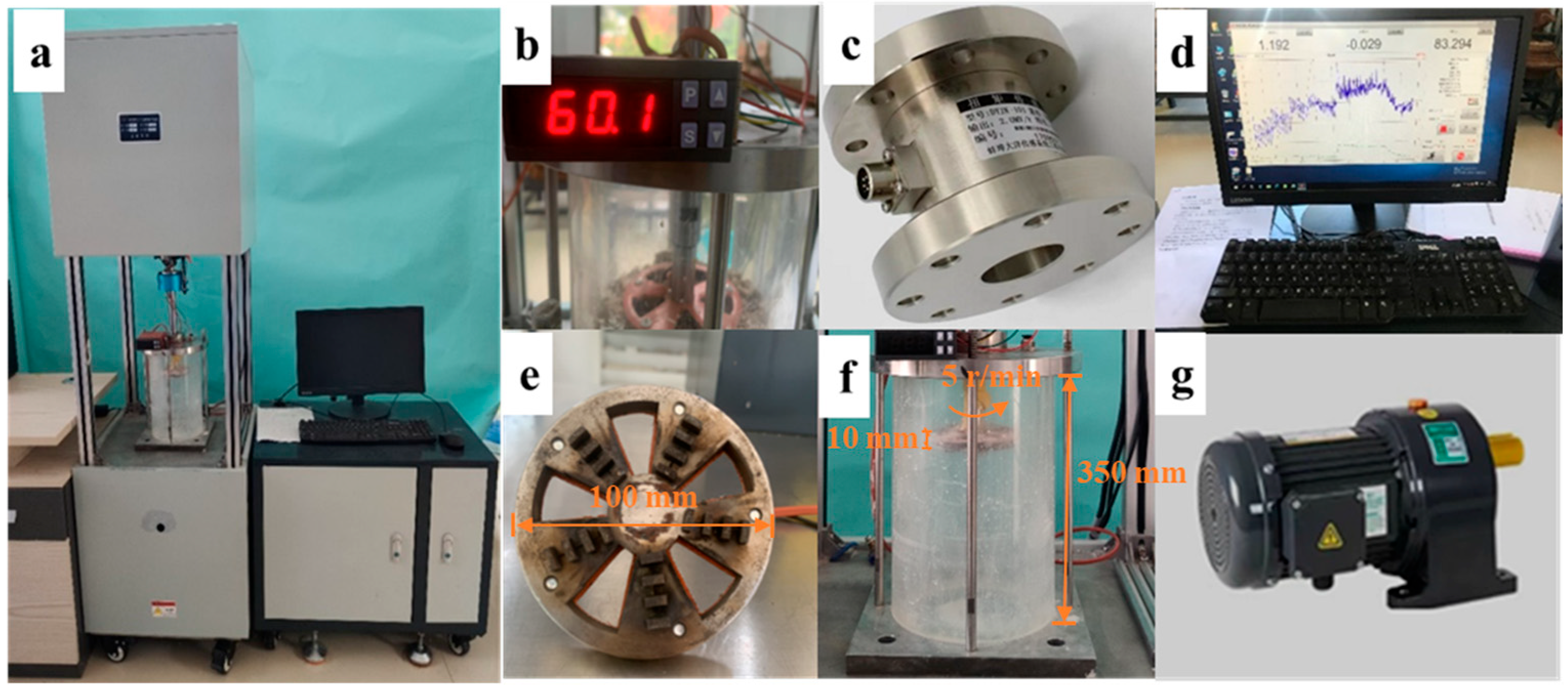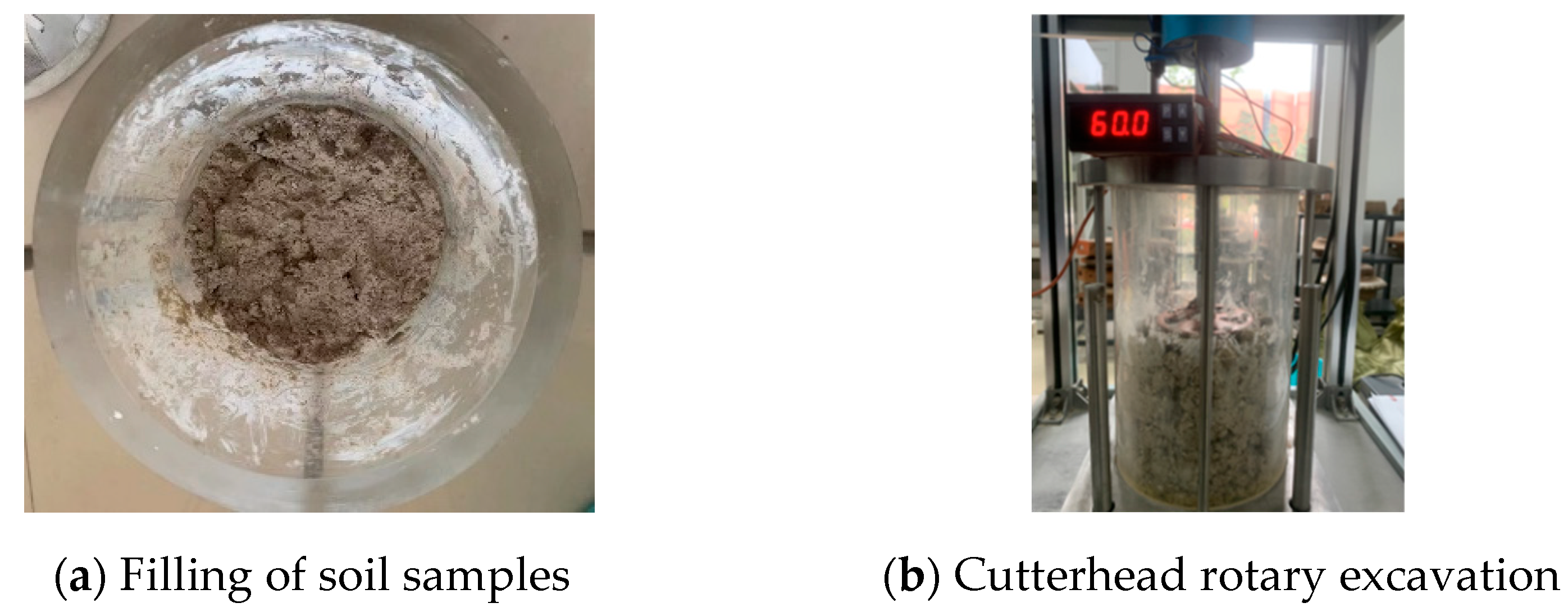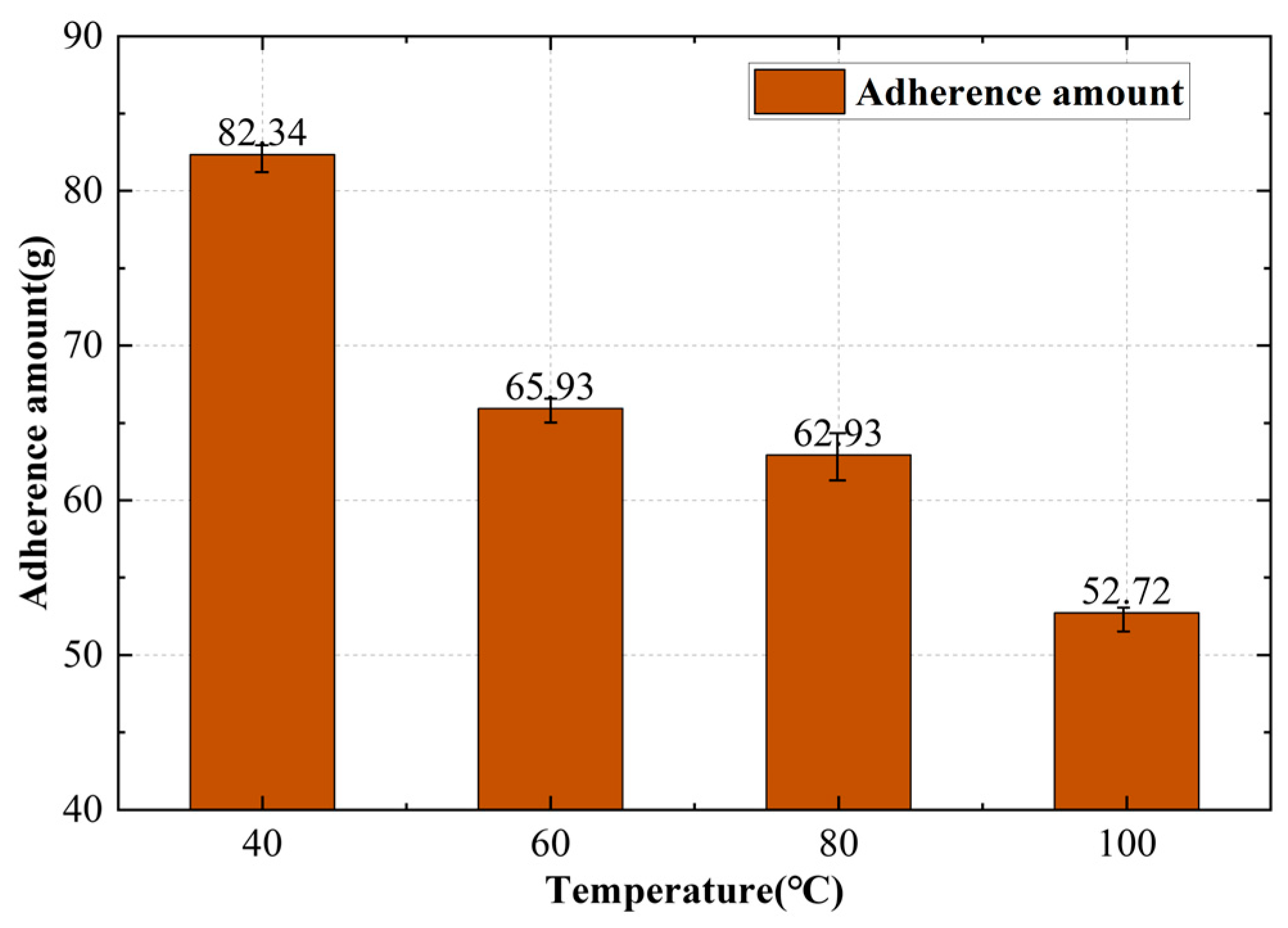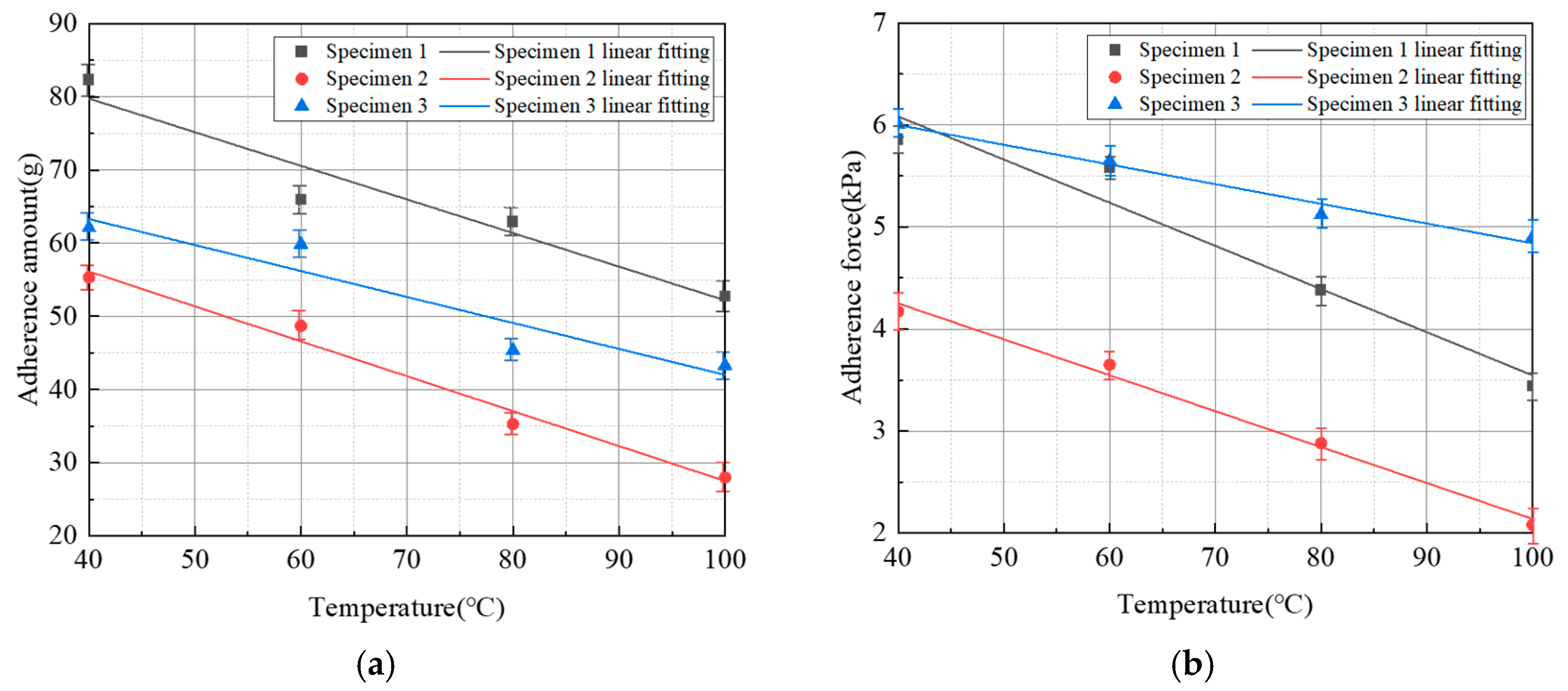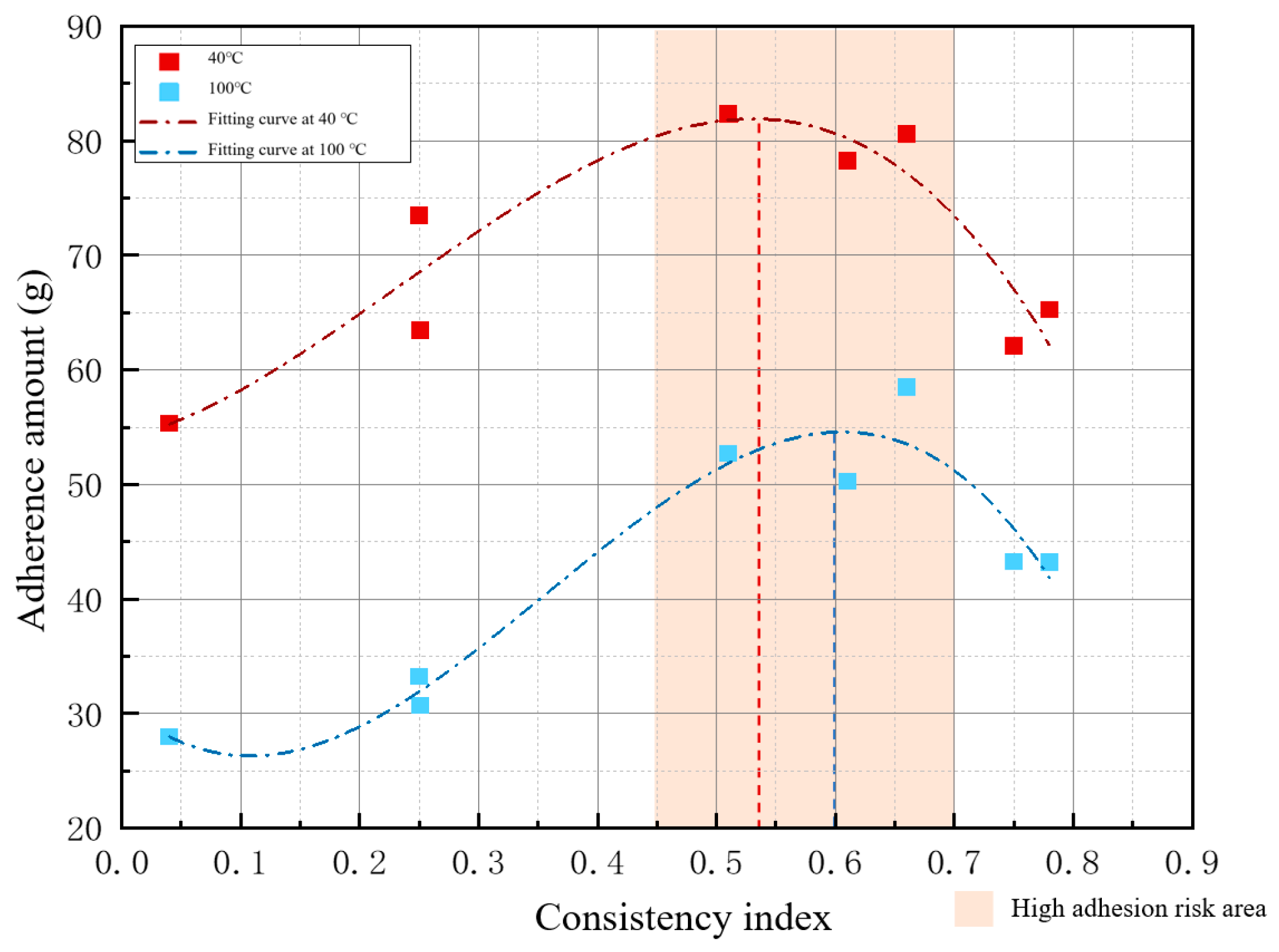1. Introduction
By virtue of its high degree of mechanization, safety and reliability, superior construction efficiency, and other characteristics, the earth pressure balance (EPB) shield method has become the main method of urban rail transit construction and is frequently applied to highway and railroad tunnels, water and electricity corridors, urban underground comprehensive pipeline corridors, and many other fields, with a wide range of products available on the market [
1,
2,
3,
4,
5]. When shielding against viscous strata, the cutter plate cuts the soil, and the soil with fine particles of viscous mineral components easily adheres to the cutter plate. The cutter plate and other mineral components—such as sand and gravel in the stratum—create friction and thus produce heat under the action of pressure and temperature, adhering to the cutter plate and the soil chamber of the clay body. This will gradually lead to cementation and hardening, producing mud cake and causing blockages [
6,
7,
8,
9]. After the mud cake and blockage are generated, they will accumulate around the cutter, which will increase the load of the cutter plate, reduce the penetration of the cutter, increase the shield thrust and torque, and wear the cutter plate significantly, causing the temperature to rise further and further solidify the surrounding clay, leading to a negative cycle which strongly affects the safety and efficiency of construction [
10,
11,
12,
13,
14].
The adhesion properties between metallic materials and cohesive soils were first studied by Fountaine (1954) [
15], who investigated and discussed the adhesion mechanism of clay–metal by means of a normal pull-out test; they determined that the adhesion force of this test was affected by the surface tension of the liquid and the contact surface, and the magnitude was approximately equal to the product of the two. Zimnik et al. (2000) [
16] used the improved straight shear test to study the law of adhesion between soil and a steel plate and to judge the adhesion strength using the magnitude of the interfacial shear. Zumsteg et al. (2016) [
17] investigated the mechanism of cutter plate cementation and the formation of mud cake through an indoor mixing test and cutter plate digging test. The results showed that the viscosity of the soil samples was positively correlated with the mud consistency and, when the viscosity of the mud increased, it enabled the adhesion of coarse-grained soils, but it also increased the risk of adhesion at the interface between the soil and the shield. For the effect of temperature on clay adhesion, Tao (2020) [
18] initially investigated the change in the interfacial adhesion strength of different clay types due to temperature using a interfacial adhesion test under high temperature and high pressure. Yang et al. (2022) [
19] determined the change in adhesion strength under different temperature conditions with different
Ic conditions via heating in a water bath. Yin et al. (2014) [
20] proved experimentally that elevated temperature can accelerate the consolidation process of soft clay. Temperature changes also cause changes in the clay strength; Lu et al. (2017) [
21] discussed the strain hardening phenomenon of pulverized clay using a temperature-controlled triaxial shear test, where the higher the temperature, the lower the undrained shear strength, and the amount of strength reduction was positively correlated with the perimeter pressure. Chen et al. (2018) [
22] investigated the effect of temperature change on the initial Young’s modulus and determined that the effect depends on the dry density of the soil sample. Zhou et al. (2012) [
23] suggested that the effect of temperature on the strength of clayey soils is closely related to the water content. Liu et al. (2025) [
24] investigated the tensile strength of compacted clayey loess and established a prediction model, highlighting the key influencing factors that control its mechanical behavior.
At present, there is a lack of in-depth research on the adhesion testing of a soil pressure balance shield cutter plate and the mechanism for residue improvement in clayey ground; the related research mainly focuses on the cutter plate design, residue improvement agent, and other aspects. There has been less research, in terms of the clay soil itself, focused on the clay content, water content, clay type, and other effects on its adhesion performance. Unlike previous studies, which primarily involved static tests (e.g., pull-out, direct shear) or simplified mixing methods, this study introduces a novel rotary adhesion tester that more accurately simulates the dynamic excavation and heating conditions of an actual EPB shield cutterhead. For the first time, this apparatus enables a systematic investigation of the combined effects of the temperature, water content, clay type, and consistency index on both the adhesion mass and force under operational conditions. The findings bridge the gap between fundamental adhesion mechanisms and practical clogging risk assessment. In this study, we carried out the cutter disk rotary adhesion test, revealing the different factors under the influence of the cutter disk to determine the clay adhesion change rule, based on the nature of clay minerals, clay–metal adhesion theory, environmental factors affecting clay minerals, and other aspects of the cutter.
2. Materials and Methods
In the actual construction process of a shield structure in viscous stratum, the cutter disk and gravel produce heat through rotation and friction, which causes the temperature of the cutter disk panel, soil cabin, and the surrounding environment to rise; with a rise in the temperature, the upper layer attached to the clay has an important impact. Hence, we carried out the cutter disk rotational adhesion test at different temperatures, in order to explore the effect of the temperature on the shield cutter disk adhesion effect and the clay and cutter disk adhesive forces, for different viscous soil samples.
2.1. Clay Samples
To investigate the adhesion characteristics of different types of clayey soils to the cutter plate and the variation in the adhesion force under different temperatures and moisture contents, laboratory-prepared samples were made using sodium bentonite, kaolin, and quartz sand. The quartz sand was sourced from China ISO standard sand, while the clay was prepared by mixing bentonite and kaolin at different mass ratios. In the prepared samples, the clay-to-sand ratios were set at 20%, 30%, and 40%, respectively, and rotary adhesion tests were conducted accordingly (
Figure 1). To ensure test consistency, each experiment was repeated three times. To achieve uniform moisture distribution, the samples were thoroughly mixed, sealed, and stored at room temperature for 24 h. The liquid and plastic limits of the samples were determined using an LP-100D soil liquid–plastic limit tester, further ensuring the consistency in sample properties across tests. The three types of clay samples are summarized in
Table 1, and the particle size distribution curve of the samples is shown in
Figure 2.
2.2. Testing Equipment
Clay adhesion and its effects on the adhesion to the cutter disk are the key factors to study during shield construction in cohesive strata. The traditional adhesion test is only used to determine some indicators of adhesion, which indirectly reflect the adhesion performance of clay. The actual shield construction process encounters viscous strata, and viscous components produce adhesion blockage, which can form a mud cake and result in increased friction. This process generates excess heat, leading to a further increase in the temperature of the cutter plate. However, the traditional adhesion measurement test does not take into account influencing factors such as the temperature and digging status; hence, it cannot determine the actual adhesion effect. In order to solve this problem and monitor and analyze the blade torque and adhesion state under different conditions during shield construction, a rotating blade adhesion test system, with adjustable blade temperature, was independently developed and used to carry out the rotating blade adhesion test.
The cutter disk rotary adhesion test system (
Figure 3) consists of four main parts: the digging system, the power system, the temperature control system, and the information acquisition system. The self-developed special cutter (
Figure 4) diameter is slightly smaller than the inner diameter of the silo, 100 mm, with a cutter thickness of 10 mm in the cutter solid part of the upper part of the heating panel. Temperature sensors were connected to the digital temperature control device through the signal line. The special cutter is fixed in the system of the synchronous rotation and digging of the main shaft. It can simulate the shield tunneling process through cutter rotation, cutter pressurization, and the warming phenomenon. The data of the cutter rotating in the soil sample in the digging process are collected through various sensors, recorded in the data acquisition system, and can be exported for data analysis. Through the torque sensor, the real-time acquisition of the torque changes from the maximum instantaneous torque can be derived according to formula (1), which corresponds to the maximum adhesion force. In the equation,
is the interfacial adhesion force,
is the instantaneous rotational torque, and
is the diameter of the cutter disk.
The adhesion process between clay and the shield cutter is influenced by factors such as the clay type, properties, temperature, and pressure. In the test design, irrelevant factors were controlled, while the relevant factors and test procedures were carefully arranged. Considering the temperature variation in the cutter during shield construction in actual viscous strata, four groups of cutter temperatures (40 °C, 60 °C, 80 °C, and 100 °C), clay types, clay content, and other variables were set, as shown in
Table 2. Each experiment was repeated three times to ensure the consistency and reliability of the results.
To ensure proper test conditions, the functions of the rotary adhesion test system were pre-tested, including the selection of the appropriate cutter rotation speed, base lifting speed, temperature setting method, and heating time. After loading the soil samples, the cutter disk was suspended and not in contact with the soil surface. The axial load and vertical displacement were reset to zero, and the base was lifted until the cutter disk fully contacted the soil surface, at which point the axial load was recorded and lifting was stopped.
The temperature of the cutter disk is controlled via a digital temperature controller, which monitors the temperature in real-time. The cutter disk was heated until it reached the set temperature, and if the temperature dropped by more than 5 °C, the heating was adjusted to maintain a stable temperature range. After pre-loading and pre-heating, the cutter’s rotational speed was set to 5 r/min and the base lifting speed to 0.1 mm/s, for a total lifting distance of 20 mm, followed by data acquisition. After the test, the data were saved and exported.
For sample preparation, the soil was placed in layers and compacted to ensure consistent density across all samples. Once the test was complete, the base was lowered, and the cutter and base were returned to their original positions. The soil sample bin was removed, data collection and cleaning were performed, and the next test began. The entire test process is shown in
Figure 5.
3. Results
3.1. Effect of Temperature on the Cutter Adhesion Test
In test groups 1–4, all variables remained the same except for the temperature; the aim was to determine the effect of temperature on the amount of adhesion of clayey soil and the adhesion force of the knife disk rotation. The results are shown in
Figure 6.
During the rotary cutter excavation process, the clay wrapped around the cutter and the tool, hindering the cutter’s rotation and forward propulsion process, due to more tool cutting into the clay, which resulted in the cutter excavation process generating a larger torque. Then, when the temperature rose, the overall rotating torque was weakened. The real-time cutter excavation torque change curve is shown in
Figure 7, where the temperature reduces the peak torque and weakens the torque fluctuations in the test process. As shown in
Figure 6 and
Figure 8, as the temperature rises, the quality of the clay block adhering to the cutter disc opening and tool clearance does not change significantly. The overall clay adhering to the surface of the cutter disc is reduced, but at the edge of the cutter disc, there will be a slate curing in the cutter disc surface of the mud layer. This is because elevated temperatures accelerate the consolidation and dehydration of clay at the cutter–soil interface, promoting the faster formation of the mud cake layer. At the same time, the consolidated clay exhibits weaker bonding capacity with the surrounding fresh clay, resulting in a decrease in adhesion on the cutter disc.
3.2. Effect of the Water Content on the Cutter Adhesion Test
In test groups 5–12, combined with the test results of test groups 1–4, the knife disk rotary adhesion test was conducted on soil sample 1 with three different water contents of 17%, 20%, and 23%, and the temperature was set to four groups of 40 °C, 60 °C, 80 °C, and 100 °C, respectively. The results are shown in
Figure 9 and
Figure 10.
The consistency index
Ic of different water contents ω of sample 1 is shown in
Table 3, where the
Ic decreases gradually with the increase in the clay water content. The adhesion force of the test group with different water contents under the same temperature conditions is shown in
Table 4. From the analysis of
Figure 10b it can be seen that, with a gradual increase in the water content of the clay sample, the rotary cutter disc torque shows a gradual decrease with the increase in the temperature in the cutter disc rotary digging process, and the overall adhesion force was reduced. The rotational adhesion force data points and fitting curves show that for the same type of clay samples, with the increase in the water content, the consistency index decreases and the rotational adhesion force also decreases gradually, agreeing with the research results of Hollmann and Thewes et al. (2016) [
11]. When the consistency index is lower, the soil body is softer and the risk of adhesion blockage is lower. As shown in
Figure 11a, in soil sample 1, as the water content of the soil body increases, the consistency index decreases, while the amount of cutter adhesion tends to increase and then decrease. The strongest clay adhesion occurs in the intermediate water content test group, when the
Ic of the clay soil sample is 0.51, and too small or large water content reduces the adhesion of the clay soil.
The data points for the amount of adhesion of the cutter disk for different test groups under this soil sample condition showed that the amount of adhesion had a decreasing trend with increasing temperature. Meanwhile, when the ω = 23%, and the temperature of the test cutter was increased from 40 °C to 100 °C, the amount of clay adhered to the cutter surface decreased from 75.49 g to 33.21 g, which was a decrease of 56%. When the ω = 17%, the amount of adhesion decreased from 65.25 g to 43.21 g, which is only 33.78%. Therefore, the high moisture content test group (ω = 23%) was more strongly affected by temperature to the low moisture content (ω = 17%) test group. Linear fitting of the group data points showed that the absolute value of the slope of the fitted straight line was small at 0.356 in the case of low moisture content, and the absolute value of the fitted straight line gradually increased with the increase in the moisture content, which also showed that the clay adhesion effect gradually increased with the temperature, along with the increase in the moisture content. When the water content is higher, and the temperature rises, a water-rich environment enhances the drainage process of the clay block, which has a larger impact on the cutter plate adhesion process, and will also more obviously affect the change in the adhesion force of the adhesion process.
3.3. Effect of the Clay Content on the Cutterhead Adhesion Test
By comparing test groups 13, 14, 17, 18, 21, 22, 25, and 26, combined with test groups 1–4, a total of twelve groups of tests were carried out on soil samples of the same clay type (
Table 5), with different clay contents, respectively, using the knife and disk rotary adhesion test, with the temperature set to 40 °C, 60 °C, 80 °C, and 100 °C for four groups. The test results are shown in
Table 6 and
Figure 12.
Figure 12a shows that the overall adhesion force and the amount of clay adhered to the cutter disk decreases with the increase in temperature. The test group with the strongest adhesion effect at the same water content is soil sample 1, and the increase or decrease in the clay content weakens the adhesion of clay to the cutter disk. Combined with the consistency index of each soil sample (
Table 4) and the analysis of the test results, we determined, with the increase in the clay content, the consistency index gradually increases, and the adhesion of the clay samples shows a tendency of increasing and then decreasing. The increase in the clay content obviously increased the knife disk rotary adhesion. This occurs because, with the increase in the clay content in the prefabricated soil samples, the sandy soil content decreases. Sandy soil is characterized by a larger friction angle, but the cohesion is almost non-existent. Hence, when the sandy soil proportion decreases, the adhesion is improved, and the tangential adhesion increases.
3.4. Effect of the Clay Type on the Cutterhead Adhesion Test
Rotary adhesion tests of the cutterhead were carried out on soil samples with modified proportions of bentonite and kaolin. The moisture content was set at 20%, and the temperatures were controlled at 40 °C, 60 °C, 80 °C, and 100 °C in four groups (see
Table 7). The test results are shown in
Table 8 and
Figure 13.
As can be seen from the test results in
Table 8 and
Figure 13, with the gradual increase in temperature, the overall law is more or less the same: the adhesion force and the amount of adhesion are reduced. However, under the same water content, with the increase in the bentonite content in clay samples within a certain range, the adhesion force slightly increases. In the completely bentonite type, that is, soil sample 6, in the case of a water content of 20% and a cutter temperature from 40 °C to 100 °C, the amount of adhesion is reduced by 27.39%. In the soil sample 5 (Bentonite:Kaolinite = 1:2), as the temperature increases to 100 °C, the amount of clay adhesion is reduced by 47.51%; hence, the relative increase in the bentonite content attenuates the effect of temperature on the adhesion of soil samples with the same water content.
However, with the gradual increase in the bentonite content in the clay under the same water content, the overall blade adhesion has a tendency to gradually increase. This is because the primary component of bentonite is montmorillonite. Compared to kaolin, montmorillonite has a stronger water absorption; that is to say, in the case of the same water content, the bentonite content of soil samples with a high consistency index is relatively higher in the range of the tested group and, when the consistency index increases, the viscous soil adhesion effect is gradually enhanced. In addition, the adhesion effect of the clay samples gradually increased as the consistency index of the clay samples increased. Similarly, for the change in the adhesion force, with the increase in the consistency index of the soil samples, the rotational adhesion force gradually increased, with the same law as the different water content test group.
5. Conclusions
This study independently developed a rotary adhesion tester to investigate the adhesion behavior of shield cutterheads in clayey strata under different temperature and soil conditions. The apparatus allows for simultaneous simulation of the cutterhead rotation, excavation, and heating, providing a closer representation of in situ tunneling conditions than traditional static tests. Based on a systematic series of rotary adhesion experiments, the following main conclusions were drawn:
- (1)
As the temperature increases, the surface tension of the water film between the metal and clay decreases, resulting in reduced cutterhead torque and a gradual decline in adhesion on the cutterhead surface. The elevated temperatures accelerate clay consolidation, and the consolidated clay exhibits weaker bonding capacity with the surrounding fresh clay, thereby reducing the overall adhesion.
- (2)
With increasing clay content, the consistency index (Ic) rises, while the cutterhead adhesion force shows a trend of first increasing and then decreasing. Among different clay types, soils with higher bentonite content exhibit higher Ic values, greater adhesion mass, and stronger rotational adhesion force compared with kaolin-rich soils, and these effects are further enhanced with the increasing bentonite content.
- (3)
The consistency index Ic can comprehensively characterize the influence of factors such as the water content and clay content on soil adhesion. The experimental results indicate that the soil adhesion exhibits a cubic functional relationship with the consistency index, and the adhesion is strongest when the consistency index falls within the range of 0.5–0.75.
While this study provides valuable insights into the adhesion behavior of clay under varying temperatures and consistency indices, several limitations should be acknowledged. Firstly, the soil samples were reconstituted in the laboratory, which may not fully represent the in situ structure, heterogeneity, and stress history of natural clay strata. Secondly, the considered temperature range (40–100 °C)—though relevant to frictional heating—might not cover all extreme scenarios encountered in very deep or prolonged tunneling operations. Thirdly, the experimental setup simulated the heating of the cutterhead but did not apply confining pressure to the soil sample simultaneously, decoupling the effects of temperature and pressure that coexist in actual shield chambers. Future research could incorporate a pressurized chamber to better simulate the in situ conditions. Lastly, the empirical model developed was based on a specific set of clays and sand mixtures; therefore, its applicability to soils with significantly different mineralogical compositions or to field-scale conditions requires further investigation.


